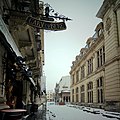Top Qs
Timeline
Chat
Perspective
Lipscani
District in Bucharest, Romania From Wikipedia, the free encyclopedia
Remove ads
Lipscani is a street and a district of Bucharest, Romania, which from the Middle Ages to the early 19th century was the most important commercial area of the city and Wallachia. It is located near the ruins of the old Princely Court built by Vlad III the Impaler.[2][3]
Remove ads
History
Summarize
Perspective
It was named after Leipzig (Lipsca in 17th century Romanian), as that was the origin of many of the wares that could be found on the main street. The word lipscan (singular of lipscani) meant trader who brought his wares from Western Europe.
All trades were found in the area, including goldsmiths, hatters, shoemakers, tanners, saddlemakers, etc., many guilds (or isnafuri) having their own street: even nowadays, the nearby streets bear the name of a trade (Blănari = Furriers street, Șelari = Saddlemakers street, etc.).
During the Communist period, the whole area was scheduled to be demolished, but this never came to fruition. The district became neglected, but nowadays is the most attractive area for tourists of all Bucharest. As of 2013, many of the buildings were restored. In the early 21st century, much of the district has been transformed into a pedestrian zone.
Known mainly for its restaurants and bars, including the Caru' cu Bere, a few shops, that feel out of place such as H&M, Adidas and Yves Rocher, have begun to appear in the area, slowly turning Lipscani into a commercial shopping district as well.[4] One should pay attention to the architecture; the mix of eclectic, baroque, brâncovenesc, general modern, and bits of brutalism all play together to form a cohesive old town that truly feels old despite the modernity.
- Carul cu Bere and Stavropoleos Church in the distance
- Monument to Vlad the Impaler inside the Old Court
- National Bank of Romania (old building)
- Macca-Villacrosse Passage
- Covaci Street
Remove ads
See also
References
Wikiwand - on
Seamless Wikipedia browsing. On steroids.
Remove ads








